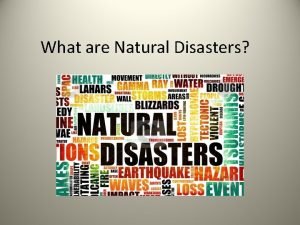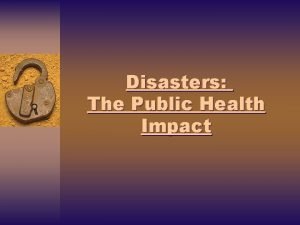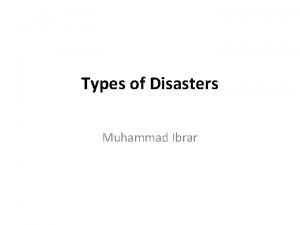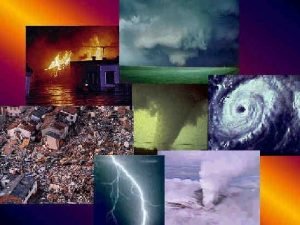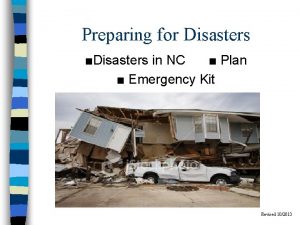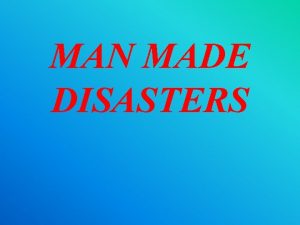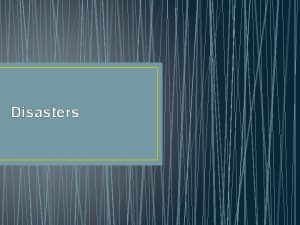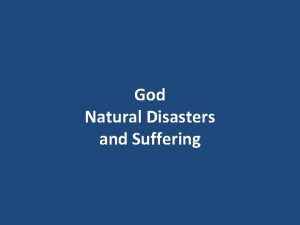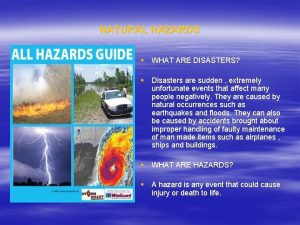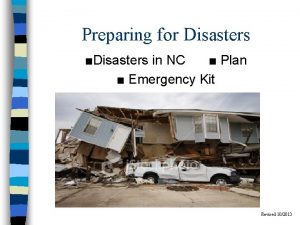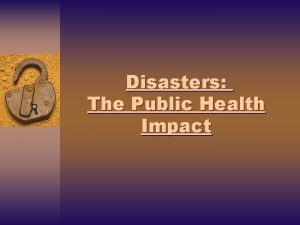Economics of Disasters Are Disasters Good for the







































































- Slides: 71

Economics of Disasters

Are Disasters Good for the Economy? Directions: • Distribute the clues so that each person is holding at least one. • Clues #1 -4: Black Death, #5 -8: Spanish Flu, #9 -10: Hurricane Katrina • Share the clues in a round-robin fashion, putting each clue into one of the following piles: • Relevant to solving the problem • Not helpful in solving the problem • Not sure • Answer the question: ARE disasters good for the economy? • Determine the least # of clues necessary to answer the question. • Be prepared to defend your answer & clue selection.

Kathy

Are Disasters Good for the Economy? NO! NO!

Scarcity IS Resources are limited Resources are necessary for production (output ƒ resources) Disasters increase resource scarcity (disasters destroy land, labor &/or capital) Output must be lower than it would have been had the disaster not occurred GDP

Activity Clue #9: J. P. Morgan senior economist Anthony Chan: "Preliminary estimates indicate 60 percent damage to downtown New Orleans. Plenty of cleanup work and rebuilding will follow in all the areas. That means over the next 12 months, there will be lots of job creation, which is good for the economy. "

Models: Tools of Economic Reasoning Production Possibilities Frontier (PPF) Assumptions of the Model: 1. All resources are used to produce the 2 categories of products on the X and Y axes 2. At all points on the curve, all resources are fully employed, given the available technology. (we choose from the possibilities) x

Models: Tools of Economic Reasoning Production Possibilities Frontier (PPF) Assumptions of the Model: 3. Technological improvements or the discovery of new resources makes more production possible. The curve moves “out, ” to the right. 4. Destruction of resources or technology makes less production possible; the curve moves “in” and “down, ” to the left.

Terminology & Measurement 1. What do we mean by “the economy” ? 2. How are we measuring it? • output = real GDP • well-being” or standard of living = real GDP/capita level • economic growth: • change in real GDP &/or real GDP/capita rate

Level vs. Rate

Economic Growth pre & post Disaster Rate? Level? O u t p u t QD Time D B disaster bottom

Economic Growth: Rate? Level? O u t p u t QD Time D disaster R recovery

Economic Growth: Rate? Level? When ? O u t p u t Q Time

Economic Growth: Rate? Level? When ? O u t p u t Q Time

Economic Growth Stimulus NO Evidence for this Scenario O u t p u t Q Time

Activity Clue #9: J. P. Morgan senior economist Anthony Chan: "Preliminary estimates indicate 60 percent damage to downtown New Orleans. Plenty of cleanup work and rebuilding will follow in all the areas. That means over the next 12 months, there will be lots of job creation, which is good for the economy. "

GDP v. GDP/capita Productivity: output per unit of input ƒ { human capital, physical capital } • skills & talents • buildings • education • machines & tools • training • technology

Labor Productivity: output person-hour ƒ {availability of capital} Effect of population change in economy with little capital

Capital to Labor Ratio capital to labor ratio falls capital to labor ratio rises

capital to labor ratio falls capital to labor ratio rises

capital to labor ratio falls capital to labor ratio rises

capital to labor ratio falls capital to labor ratio rises

capital to labor ratio falls capital to labor ratio rises

capital to labor ratio falls capital to labor ratio rises

capital to labor ratio falls capital to labor ratio rises

Are Disasters Good for the Economy? NO! NO! NO! • Resources are destroyed • Total output ( real GDP) falls the PPF always shrinks

Why Might Disasters SEEM To Be Good for the Economy? economic “well-being” standard of living (real GDP/capita) When capital to labor ratios rise, real GDP/capita may rise even as total real GDP falls

Activity Clue #9: J. P. Morgan senior economist Anthony Chan: "Preliminary estimates indicate 60 percent damage to downtown New Orleans. Plenty of cleanup work and rebuilding will follow in all the areas. That means over the next 12 months, there will be lots of job creation, which is good for the economy. " Questions to Ask: • Is this a credible source? • If so, are the standards for comparison specified? (What are you measuring? )

Debbie

Frédéric Bastiat “There is only one difference between a bad economist and a good one: the bad economist confines himself to the visible effect; the good economist takes into account both the effect that can be seen and those effects that must be foreseen. ”

“What Is Seen and What Is Not Seen” Economic Sophisms, 1845 “The Broken Window Fallacy” Suppose James Goodfellow’s son breaks a window.

"It's an ill wind that blows nobody some good. Such accidents keep industry going. Everybody has to make a living. What would become of the glaziers if no one ever broke a window? "

. . . Suppose that it will cost six francs to repair the damage. . The glazier will come, do his job, receive six francs, congratulate himself, and bless in his heart the careless child. That is what is seen. But if, by way of deduction, you conclude, as happens only too often, that it is good to break windows, that it helps to circulate money, that it results in encouraging industry in general, I am obliged to cry out: That will never do! Your theory stops at what is seen. It does not take account of what is not seen. ”

It is not seen that if he had not had a windowpane to replace, he would have replaced, for example, his wornout shoes or added another book to his library. Let us next consider industry in general. The window having been broken, the glass industry gets six francs' worth of encouragement; that is what is seen. If the window had not been broken, the shoe industry (or some other) would have received six francs' worth of encouragement; that is what is not seen.

Frédéric Bastiat . . . Destruction is not profitable. ”

He Should Know Better: "Ghastly as it may seem to say this, the terror attack. . . could do some economic good. " [. . . destruction will stimulate the economy through business investment in rebuilding]. Paul Krugman, Princeton University New York Times, Sept. 14, 2001 Bastiat Hasn’t Been Forgotten: We know this has to be fishy just by asking: Would there have been even greater "economic good" had the terrorists succeeded in destroying buildings in Los Angeles, San Francisco, Chicago, Philadelphia, Boston and all other major cities? Of course, you and I know that is utter nonsense. Property destruction always lowers the wealth of a nation. I hope one of Krugman's students asks him, "If property destruction is good for the economy, why aren't Beirut and Belfast boom towns? Walter Williams, George Mason University http: //www. jewishworldreview. com/cols/williams 100401. asp

"If property destruction is good for the economy, why aren't Beirut and Belfast boom towns? ”

Not Everyone Is Hurt By Disasters Fallacy of Composition: To erroneously assume that what is true of the whole is true of an individual. Economic change creates winners and losers.

And the Winners Are. . .

Lesson 2: When Disaster Strikes, What Can Markets Do? • Prices & information • Supply shocks • Consumption shocks

Review/Reminder: Why do we ration? Scarcity IS Scarcity requires rationing – the question is not whether to ration, but which method of rationing to use addresses scarcity. Guideline for choice among alternatives: • Which provides us with the greatest excess of benefits over costs? • (or, another way to say it is, “Which best addresses scarcity? ”)

Why do we ration through markets? What markets do best: 1. Transmit information to decision-makers 2. Direct resources to their most highly valued uses 3. Encourage the least-cost use of resources, including human time and effort

Information & Knowledge Frederich von Hayek: The essential task of economic systems: rapid adaptation to the changes in the particular circumstances of time and place The nature of knowledge and information: information about the particular circumstances of time and place is localized and widely dispersed, BUT, unlike central planners, economic decision-makers in markets only need SOME of that information

Prices transmit information “Assume that somewhere in the world a new opportunity for the use of some raw materials, say tin, has arisen, or that one of the sources of supply of tin has been eliminated. It does not matter. . . which of these two causes has made tin more scarce. All that the users of tin need to know is [what the higher price tells them—] The whole acts as one market, not because any of its members survey the whole field. . . [but because] individual fields of vision sufficiently overlap so that through many intermediaries the relevant information is communicated to all. ”


Information in Disaster: Who Knew? 1. Relief work clearing debris and reaching coastal communities in Banda Aceh was delayed until what could be acquired after the 2004 Asian tsunami?

Information in Disaster: Who Knew? 2. If you had been in charge of setting up a survivor daily -supply store after Hurricane Katrina, what 3 items would you have stocked?

Information in Disaster: Who Knew? 3. If you had been in charge of taking care of displaced pets after Hurricane Rita, what non-food item would you have taken to Houston in your supply truck?

Information in Disaster: Who Knew? 4. What relief item is most likely to be oversupplied after a disaster?

Information in Disaster: Who Knew? 5. You’re in charge of emergency medical care in Haiti. What piece of equipment will you need to function in this impoverished undeveloped country?

Information in Disaster: Who Knew? 6. You’re in charge of helping people who need to communicate with friends and relatives after Hurricane Sandy. What equipment will meet immediate needs until infrastructure can be repaired?

http: //www. youtube. com/watch? v=R 6 oj. Yt. Kazg. Q

Kathy

Models: Tools of Economic Reasoning Market Analysis: Supply Shock 1. 2. 3. 4. Disasters destroy resources. Less can be produced; output falls. Price rises. Quantity purchased falls. Safter $ Sbefore D P Q before & after

Models: Tools of Economic Reasoning Market Analysis: Supply Shock Higher prices have 2 effects: Consumers buy less. (They substitute. ) Producers offer more for sale. (They also substitute. ) Safter $ Sbefore P D before & after Q Question: In a disaster, is this a good thing or a bad thing?

Models: Tools of Economic Reasoning Market Analysis: Consumption Shock 1. 2. Disasters destroy resources. Demand shifts because of changes in the prices of substitutes. (ice for refrigeration, for example) 3. 4. S $ Price rises. Greater quantity (of ice) is offered for sale. before & after Dafter P Dbefore Q

Models: Tools of Economic Reasoning Market Analysis: Consumption Shock S Higher prices have 2 effects: Consumers buy less. Producers offer more for sale. before & after $ Dafter P Dbefore Q Question: Is that a bad thing for disaster victims? (in general? individually? ) 2 nd Question: If it is, what can be done to help them?

Profit is the motivator: Markets don’t wait for disasters; they prepare. • State Farm Insurance • Wal-Mart • Home Depot • Fed-Ex • Black & Decker • Disaster-preparedness industry – because there’s profit in doing so.

Case Studies in Lesson 2 The housing market after the Great Chicago Fire of 1871 Wal Mart, Home Depot, & State Farm Insurance after Hurricane Katrina Market allocation of gasoline after Hurricane Katrina

The Gasoline Market Responded to Sandy: “Disasterpreneurs” “The Gas Price Story of Hurricane Sandy”: Markets emerge, even when you try to stop them. And they work. http: //lfb. org/the-gas-price-story-of-hurricane-sandy/

The Gasoline Market Responded to Sandy: “Disasterpreneurs” article http: //lfb. org/today/the-gas-price-story-of-hurricane-sandy/ video http: //www. youtube. com/watch? v=USG 7 j 8 b. P_l 4 Thru 7: 30

What Can Markets Do in Disasters? Markets can do what they do best – whethere is a disaster or not: ◦ communicate information about relative scarcities ◦ use price signals to allocate goods, services, and resources to their most highly valued uses (What about “price-gouging”? Activity this afternoon. ) Caveat: Markets can only do what they do best IF the rules of the game allow them to do so. . Lesson 3

Market for Thing-a-ma-jigs

How to Play… BUYERS Goal: PROFIT • Each buyer will have only one buyer card at a time. The card will allow you to buy ONE thingamajig and will tell you how much you value it. To make a “profit, ” buy at a price lower than the price shown on your card. If you buy at a higher price, you suffer a loss. • DO NOT REVEAL THE PRICE. • Record the buyer card price on your student score sheet. • When the round starts, try to buy below your buyer-card price – the lower, the better. (You may buy at a price higher than that on your buyer card, but note that this will reduce your “profit” for the round. ) • When you make a purchase, record the transaction price on your score sheet. Then, turn in the buyer card and get another buyer card from the buyer pile.

How to Play… Sellers Goal: PROFIT • At the beginning of each round, each seller will be given an inventory of Thingamajigs and a role card with the cost per thingamajig. To make profit, sell at a price higher than the cost. If you sell at a lower price, you suffer a loss. • DO NOT REVEAL THE PRICE. • Record the seller card price on your student score sheet.

How to Play… BUYERS & SELLERS • All stores are open to all buyers. • When a buyer and seller agree on a price, they record the transaction on their transaction records, and the seller gives the Thingamajig to the buyer. • The BUYER must then report the transaction by turning in the Thingamajig card to the person keeping the Market Tally in the front of the room. The buyer may then exchange his buyer card for another and try to make another purchase.

How to Play… BUYERS & SELLERS • When the teacher says “Start, ” sellers and buyers are free to move around the room and to make transactions with one another. Any seller may talk with any buyer. • Both buyers and sellers are free to make as many transactions as they want in a round. Buyers, remember to turn in your Thingamajig card to the tally keeper and get a new buyer card after each transaction. • During the game, keep track of your progress on the student score sheet. Compute your gains and losses by taking the difference between the price on your buyer or seller card and the price of the transaction.

Let’s Play! ROUND 1

Let’s Play! ROUND 1 2 3 4

Transaction Tally

Learn. Liberty: Is Price Gouging Immoral? Should It Be Illegal? http: //www. learnliberty. org/videos/price-gouging-immoral-should-itbe-illegal/
 Antigentest åre
Antigentest åre Good thoughts good words good actions
Good thoughts good words good actions Hello teacher good afternoon
Hello teacher good afternoon Hi good morning video
Hi good morning video Cómo se dice buenas tardes
Cómo se dice buenas tardes You are good you are good when theres nothing good in me
You are good you are good when theres nothing good in me Economics and business economics maastricht
Economics and business economics maastricht What is mathematical economics
What is mathematical economics Myndigheten för delaktighet
Myndigheten för delaktighet Tack för att ni har lyssnat
Tack för att ni har lyssnat Kung som dog 1611
Kung som dog 1611 Tack för att ni lyssnade
Tack för att ni lyssnade Rutin för avvikelsehantering
Rutin för avvikelsehantering Klassificeringsstruktur för kommunala verksamheter
Klassificeringsstruktur för kommunala verksamheter Tobinskatten för och nackdelar
Tobinskatten för och nackdelar Presentera för publik crossboss
Presentera för publik crossboss Formuö
Formuö Att skriva en debattartikel
Att skriva en debattartikel Karttecken kraftledning
Karttecken kraftledning Vad är vanlig celldelning
Vad är vanlig celldelning Rbk mätning
Rbk mätning Referat mall
Referat mall Elektronik för barn
Elektronik för barn Varför kallas perioden 1918-1939 för mellankrigstiden
Varför kallas perioden 1918-1939 för mellankrigstiden Lågenergihus nyproduktion
Lågenergihus nyproduktion Tack för att ni har lyssnat
Tack för att ni har lyssnat Formel för lufttryck
Formel för lufttryck Förklara densitet för barn
Förklara densitet för barn Frgar
Frgar Mindre än tecken
Mindre än tecken Smärtskolan kunskap för livet
Smärtskolan kunskap för livet Humanitr
Humanitr Typiska novell drag
Typiska novell drag Epiteltyper
Epiteltyper Toppslätskivling effekt
Toppslätskivling effekt Argument för teckenspråk som minoritetsspråk
Argument för teckenspråk som minoritetsspråk Borra hål för knoppar
Borra hål för knoppar Delegerande ledarskap
Delegerande ledarskap Bris för vuxna
Bris för vuxna Gumman cirkel sång
Gumman cirkel sång Etik och ledarskap etisk kod för chefer
Etik och ledarskap etisk kod för chefer Redogör för vad psykologi är
Redogör för vad psykologi är Fredsgudinnan
Fredsgudinnan En lathund för arbete med kontinuitetshantering
En lathund för arbete med kontinuitetshantering Bra mat för unga idrottare
Bra mat för unga idrottare Steg för steg rita
Steg för steg rita Publik sektor
Publik sektor Datorkunskap för nybörjare
Datorkunskap för nybörjare Tillitsbaserad ledning
Tillitsbaserad ledning Lyrik
Lyrik Ministerstyre för och nackdelar
Ministerstyre för och nackdelar Tack för att ni lyssnade bild
Tack för att ni lyssnade bild Bästa kameran för astrofoto
Bästa kameran för astrofoto Modell för handledningsprocess
Modell för handledningsprocess Kanaans land
Kanaans land Vilken grundregel finns det för tronföljden i sverige?
Vilken grundregel finns det för tronföljden i sverige? Nyckelkompetenser för livslångt lärande
Nyckelkompetenser för livslångt lärande Bamse för de yngsta
Bamse för de yngsta Vishnuismen
Vishnuismen Personlig tidbok fylla i
Personlig tidbok fylla i Expektans eller exspektans
Expektans eller exspektans Stål för stötfångarsystem
Stål för stötfångarsystem Strategi för svensk viltförvaltning
Strategi för svensk viltförvaltning Adressändring ideell förening
Adressändring ideell förening Romarriket tidslinje
Romarriket tidslinje Verktyg för automatisering av utbetalningar
Verktyg för automatisering av utbetalningar Informationskartläggning
Informationskartläggning Lyckans minut erik lindorm analys
Lyckans minut erik lindorm analys Stig kerman
Stig kerman Läkarutlåtande för livränta
Läkarutlåtande för livränta Inköpsprocessen steg för steg
Inköpsprocessen steg för steg Tack för att ni har lyssnat
Tack för att ni har lyssnat














































































